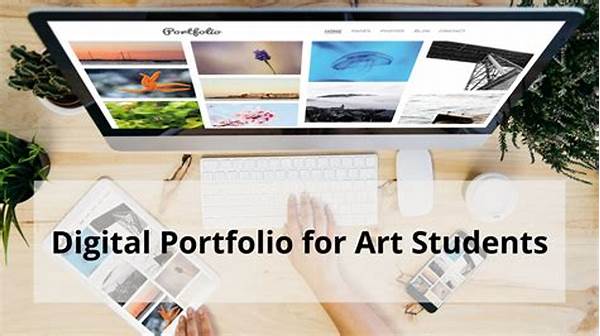Embarking on the journey of becoming a successful artist requires more than just raw talent. One essential aspect that opens doors to opportunities is building an artist portfolio. This carefully crafted collection of your best works not only showcases your skills but also communicates your artistic voice to potential clients, galleries, and collaborators. A well-constructed artist portfolio holds the power to propel your career into new territories.
Read Now : Interactive Installation Art Partnerships
Crafting a Compelling Artist Portfolio
When building an artist portfolio, it is imperative to understand the components that make it stand out. Firstly, your portfolio should include a carefully curated selection of your art pieces that best represent your style and capabilities. Include high-quality images of each piece, ensuring they are well-lit and focused. This visual representation is the first impression you will make, so it must be impressive. Additionally, consider including a brief artist statement, explaining your inspirations and creative process. This insight provides context and allows viewers to connect with your work on a deeper level. Lastly, ensure that your contact information is easy to find, making it uncomplicated for interested parties to reach out for inquiries or opportunities. Building an artist portfolio with these elements ensures you present yourself professionally and captivatingly to your audience.
Organizing your portfolio effectively is crucial. Start with your strongest pieces to grab attention immediately. Diversify your selection to demonstrate your versatility while maintaining a cohesive artistic theme. A well-organized portfolio avoids overwhelming viewers and presents your body of work in a digestible flow. Regularly update your portfolio to reflect your growth as an artist. By building an artist portfolio with this mindful approach, you portray yourself as a serious professional dedicated to your craft.
Technology offers incredible tools for exhibiting your portfolio. Creating a personal website can serve as an online gallery that is accessible to a global audience. Utilize social media platforms to share your work and reach wider communities. Investing time in a digital presence, in addition to a physical portfolio, significantly broadens your opportunities. In today’s world, building an artist portfolio that leverages digital tools can greatly enhance your visibility and impact.
Key Steps in Building an Artist Portfolio
1. Curate Your Best Work: Highlight your most impactful and representative art to set the tone for your artistic voice. Building an artist portfolio that emphasizes quality over quantity is crucial.
2. Include an Artist Statement: Provide a narrative about your artistic journey and inspiration. A personal touch can differentiate your portfolio, adding depth to your collection.
3. Organize Cohesively: Arrange your portfolio logically, starting with strong pieces. This organization enhances the viewing experience, making it seamless and engaging.
4. Embrace Digital Platforms: Use websites and social media to expand your reach and showcase your work globally. In building an artist portfolio, digital presence plays an important role.
5. Update Regularly: Keep your portfolio current with new pieces and improvements. An up-to-date portfolio reflects your development and keeps your audience interested.
The Importance of Artist Portfolios in Career Growth
A well-constructed artist portfolio is quintessential in fostering career development. Building an artist portfolio that resonates with audiences can lead to various opportunities such as exhibitions, commissions, and collaborations. It serves as your professional calling card in the art world. Potential clients and galleries first interact with your portfolio; thus, it needs to convey your skills and artistic perspective effectively.
Moreover, a thoughtfully curated portfolio bolsters your confidence as an artist. The process of selecting and organizing your best works allows for self-reflection and assessment of your journey. Recognizing growth and areas of improvement contributes to a cycle of continuous advancement in your craft. Building an artist portfolio is not merely a task; it is a strategic investment in your artistic career.
Strategies for Building an Effective Artist Portfolio
1. Research Industry Standards: Understanding what galleries and collectors look for guides you in building an artist portfolio that meets professional criteria.
2. Balance Versatility with Cohesiveness: Include a range of works that display your skill set while maintaining an identifiable style throughout your portfolio.
3. Utilize Feedback: Seek critiques from peers and mentors to refine your portfolio. Constructive criticism is invaluable in the building process.
4. Consider Your Audience: Tailor your portfolio content to resonate with your intended viewers, enhancing its effectiveness.
5. Tell a Story: Craft a narrative across your portfolio, drawing viewers into a compelling artistic journey.
6. Develop a Strong Online Presence: Expand your portfolio’s reach by utilizing digital tools to engage a broader audience.
Read Now : Aligned Multimedia Marketing Presentations
7. Handle Physical Presentation with Care: If presenting in-person, ensure prints and materials used are of high quality to make a lasting impression.
8. Set Clear Goals: Define what you hope to achieve with your portfolio, aiding in focused content creation and presentation.
9. Stay True to Your Vision: Authenticity is key; ensure your portfolio reflects your genuine artistic identity.
10. Practice Consistency: Develop and adhere to a visual language that remains consistent throughout, strengthening your brand as an artist.
Creating an Onlinе Artist Portfolio
Building an artist portfolio online is a modern necessity. An online presence amplifies your reach beyond geographical boundaries, connecting you with a global audience. Start by selecting a user-friendly platform to build your virtual portfolio. Websites like Squarespace, Wix, and Adobe Portfolio offer customizable templates tailored for artists. Reflect on your aesthetic preferences while designing your site, ensuring it complements your artwork instead of overpowering it.
Ensure your digital portfolio is easy to navigate. A clutter-free design guides visitors to your artwork without distractions. As in physical portfolios, maintain high-quality images and concise descriptions of your pieces. Incorporate a clearly visible section with your biography and artist statement, giving visitors insight into your creative vision. Additionally, include a contact page and integrate social media links to facilitate seamless communication with potential clients and followers. Building an artist portfolio online is instrumental in establishing a reputable digital presence.
Regular updates to your online portfolio are crucial. As your style evolves, ensure your virtual gallery mirrors this evolution. Offer exclusive glimpses into your creative process through blog posts or video content, engaging visitors in your artistic journey. Online platforms provide the flexibility to share your artistry in innovative ways, ensuring that your audience stays connected and invested in your work. In today’s digital age, building an artist portfolio that thrives online is fundamental for a successful art career.
Enhancing Portfolio Impact with Personal Branding
Building an artist portfolio is part of a broader strategy of personal branding. Effective branding distinguishes you in a competitive art landscape. Start by defining a clear artistic identity that reflects your values, themes, and techniques. This identity should permeate every aspect of your portfolio, from the selection of works to the visual presentation.
Develop a consistent visual language and style. Whether through color schemes, typography, or photographic style, ensure your portfolio reflects a unified brand image. Your logo or signature can serve as symbolic identifiers, enhancing recognition. Additionally, crafting a compelling narrative about your artistic journey can resonate emotionally with viewers, establishing a deeper connection.
Collaborating with other artists or engaging in community projects strengthens your brand and adds credibility to your portfolio. Share these experiences as part of your artistic story. Embrace social media as a tool for extending your brand’s reach, engaging with your audience through authentic and interactive content. Remember, in building an artist portfolio, the notion of personal branding plays an integral role. The synergy between these elements propels your career, fostering recognition and long-term success.
Recap on Building an Artist Portfolio
Embarking on the journey of building an artist portfolio requires a blend of creativity and strategy. This process involves a carefully curated selection of artworks that represent your unique artistic voice. Begin by choosing pieces that not only highlight your skill but also convey your personal style and thematic focus. As you craft your portfolio, remember that quality takes precedence over quantity, offering an impactful glimpse into your capabilities.
Building an artist portfolio is an ongoing endeavor. Frequent updates reflecting your artistic growth keep your presentation fresh and relevant. Balancing a digital and physical portfolio maximizes your reach, ensuring accessibility and visibility across various platforms. Utilize the tools at your disposal, from personalized websites to social media engagement, to create a comprehensive and appealing portfolio that captivates potential audiences.
Ultimately, the essence of building an artist portfolio lies in its ability to open doors to new opportunities and connections in the art world. It serves as a bridge that links your creative aspirations with the broader artistic community. Approach this task with diligence, creativity, and authenticity, knowing that each step contributes to defining your place in the art industry.



